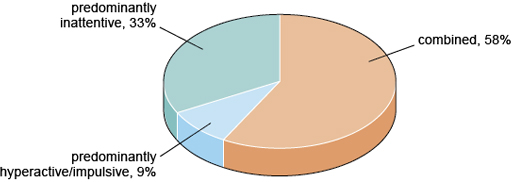1.3.1 Diagnosing ADHD with DSM-5
According to the DSM-5, for ADHD to be diagnosed:
- Symptoms of inattention or hyperactivity/impulsivity (Table 2) must have been present for a minimum of six months.
- The number of symptoms that must be present depends on the age of the individual:
- for children up to the age of 16, at least six symptoms
- for adolescents 17 years of age or older and adults, at least five symptoms.
- At least some symptoms must be present before 12 years of age. Note that this contrasts with the previous DSM-IV-TR criterion of symptoms being present at age 7 years which was mentioned by Dr Rathwell in Activity 1.
- Some symptoms must be present in two or more settings, for example, at school and at home.
- There must be evidence that symptoms are reducing the functioning of the individual, for example, at school, socially or in the workplace.
- Other conditions that could cause the same symptoms must first be ruled out.
| Inattention | Hyperactivity/Impulsivity |
|---|---|
Often fails to give close attention to details or makes careless mistakes with work. Often has trouble holding attention in tasks. Often does not seem to listen when spoken to directly. Often does not follow through on instructions, and fails to finish schoolwork, chores. Often has trouble organising tasks and activities. Often avoids doing tasks that require mental effort over a long period of time. Often loses things necessary for tasks and activities. Is often easily distracted. Is often forgetful in daily activities. |
Often fidgets with/or taps hands or feet, or squirms in seat. Often leaves seat in situations where it is not allowed. Often runs about or climbs in situations where it is not appropriate. Often unable to take part in leisure activities quietly. Is often ‘on the go’ as if ‘driven by a motor’. Often talks excessively. Often blurts out answers before appropriate. Often has trouble waiting his/her turn. Often interrupts or intrudes on others. |
Recall from Section 1.1 that it has been suggested that adults with ADHD may not simply be the children and adolescents with the condition who grew up.
-
Look at the diagnostic criteria listed for DSM-5. Do they allow diagnosis where an individual only develops the symptoms as an adult?
-
No, some symptoms must be present as a child for ADHD to be diagnosed. This means that it is not possible to diagnose ADHD if no symptoms were present as a child.
At the time of writing (2019-2020) then, the DSM does not allow for adult onset of ADHD symptoms. However, using the DSM-5 criteria, it is possible that an individual may have had some symptoms as a child but not enough to receive a diagnosis, until other symptoms developed as an adult.
-
In this case, what difficulty may occur in identifying the symptoms present as a child?
-
It relies on an individual remembering experiences from this age which may not be accurate.
Based on the symptoms presented in Table 2, the DSM-5 differentiates between three different subtypes of ADHD, referred to as ‘presentations’:
- Predominantly inattentive presentation (ADHD-I): symptoms of inattention, but not hyperactivity/impulsivity
- Predominantly hyperactive/impulsive presentation (ADHD-HI): symptoms of hyperactivity/impulsivity, but not inattention
- Combined presentation (ADHD-C): symptoms of both inattention and hyperactivity/impulsivity
The first type of ADHD, the predominantly inattentive presentation, is also sometimes referred to as attention deficit disorder (ADD). However, strictly speaking, ADD is no longer a diagnostic term – it was changed to ADHD in the DSM-IV and therefore, since 1994, healthcare professionals using the DSM have used the term ADHD-I for this presentation type.
The proportion of the different types of ADHD is shown in Figure 3.

-
Is it possible to have a diagnosis of ADHD without symptoms of inattention according to DSM-5? Explain your answer using Figure 3.
-
Yes, it is possible. An individual can exhibit only symptoms of hyperactivity or impulsivity in which case they would be diagnosed with the predominantly hyperactive/impulsive presentation of ADHD. This is found in around 9% of individuals with ADHD.
